After the Road Scholar Program was over, we drove to Newark Airport where I had arranged to leave the car. From the airport we took the train to NYC where we stayed at a Doubletree Hotel across the street from the Rockefeller Center. I had chosen it for its proximity to the ballet venue. It was a nice hotel, but the neighborhood was NOISY! NYC has recovered from the COVID shutdown!
Since we had an extra day in New York City, I did some research on must-see excursions. One that popped up was the Hard Hat Tour of the abandoned Ellis Island Hospital complex. We decided to give the 90-minute tour (3-hour total time including the ferry ride) a try. It was well worth it.
The hospital was active between 1902 and, at reduced capacity, until 1951. Over 275,000 patients were treated there. 4,000 died, but 350 babies were born. In 1951 the hospital was abandoned and has been deteriorating ever since.
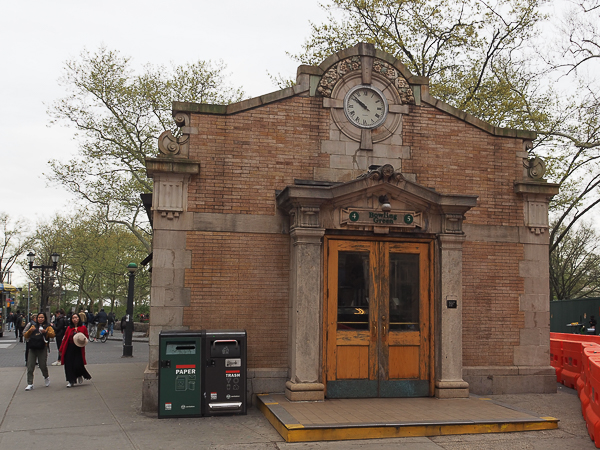
We took the subway to Battery Park to catch the ferry to the island. This isn't the actual exit we used for Bowling Green, but it was an active one. It was built in 1905 and is on the National Register of Historic Places.
The effects of age are such that we headed for the elevator entrance rather than use the historic one.
With our timed tickets for the Hard Hat Tour, we were able to bypass the VERY long general admission line. Next to us in line was a family with "pedestal" tickets for the Statue of Liberty. They were originally from Italy, but now lived in Switzerland. One spoke some English and I got to wheel out my rusty German. We had a nice chat. The grandmother had a foam Liberty crown and with that and a rolled up newspaper for a torch, she made a rakish Lady Liberty!
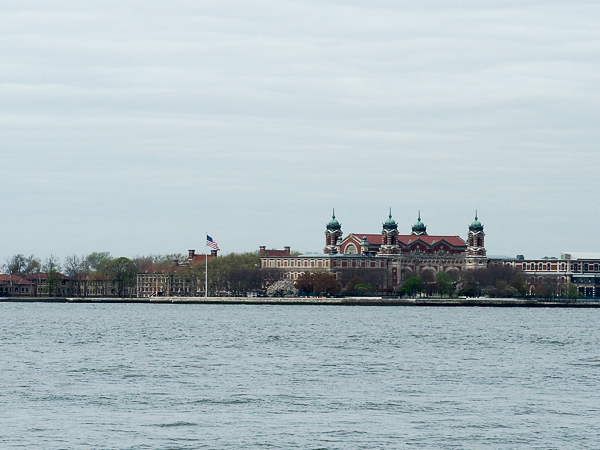
The first stop was at Liberty Island. Then the boat proceeded to Ellis Island.
The iconic main building contained the Main Hall or Registry Room for new immigrants. It is a National Monument administered by the Park Service.
Check the link for an online tour of Ellis Island illustrating the process each immigrant faced. It includes text, pictures, audio & video. We did not have time to visit the extensive museum in the main building.
Most immigrants made it through in a few hours. It's the unlucky few who suffered from disease that concern us on this trip.
Prior to 1890 immigration was the purview of the various states, but at that time it was taken over by the U.S. A Congressional committee determined to place the immigration facility on Ellis Island and most of the existing buildings were removed to allow construction of the new facility. The first iteration was of wood. When it burned, destroying all records, a "fire proof" structure was stipulated. That is the one we see today.
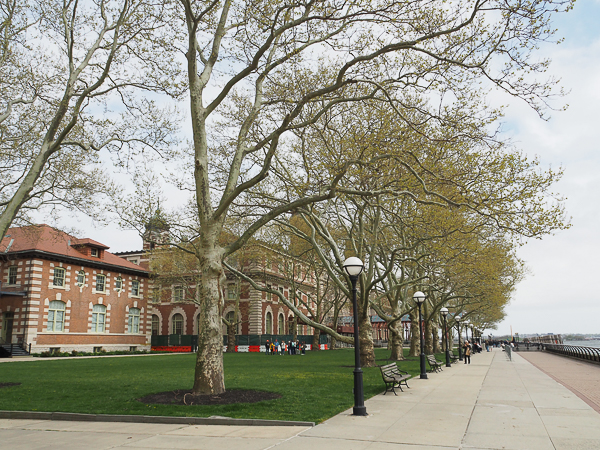
The majority of immigrants rode in tenders to the main processing facility. Pictures at the link show what it looked like back then, with crowds of people waiting on the steps to get in.
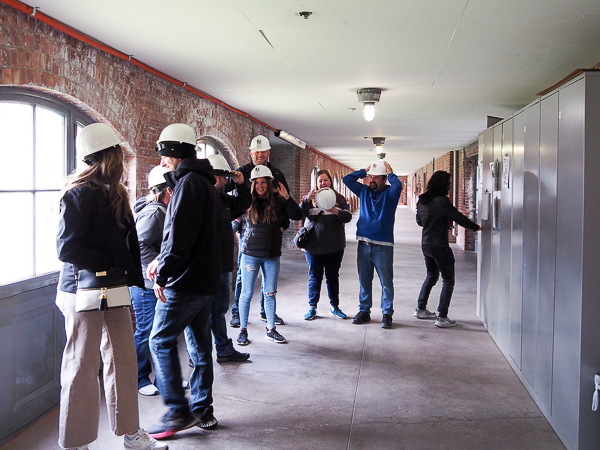
Getting fitted with our hard hats for the tour.
The guide gave us a brief history of the island itself. It got its name from Samuel Ellis who owned it in the late 18th century. In 1810 the island passed to the U.S. Government, which constructed a fort -- part of a series of forts protecting the harbor. In 1834 the island was declared to be an enclave of New York in New Jersey waters.
Excavations for the New York City subways provided fill to create a new island to house the hospital. Eventually "Ellis Island" comprised three islands.
After the hospitals were closed, the two man-made islands were transferred back to New Jersey although the main island remains part of New York. Our guide joked that the land that was originally New Jersey is now New York, whereas the land that was originally New York is now New Jersey. There is a causeway reaching to the two NJ islands to the mainland.
This long hallway connecting the main facility and the hospitals was the path of those unlucky immigrants who did not pass the initial health check.
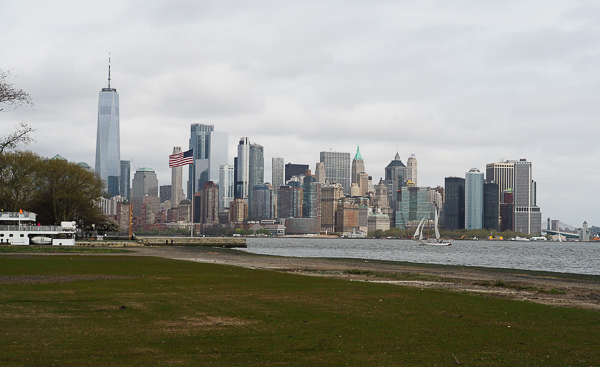
So near, and yet so far!
The skyline has changed, but it must have been devastating to be pulled out of line. It had taken, perhaps, years of preparation and, certainly, months of anxious travel to get this far. And now to have that all in jeopardy.
Only 2% of immigrants were refused admission, but those who were diverted to the hospitals could not know their eventual fate.
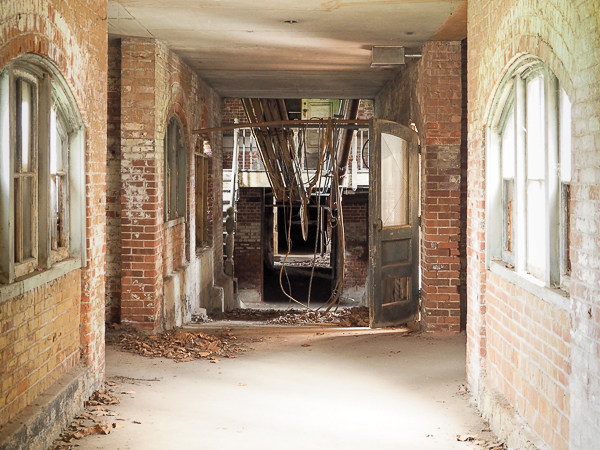
Lest we questioned the need for hard hats!
That area was not part of the tour. The guide informed us that we were probably more in danger from panicked pigeons than falling ceilings.
Recently an opinion piece published by the New York times included a 1974 film of an abandoned Ellis Island made by a couple of teenagers. At that time the main facility was in as a dilapidated state as the hospital is now. I hope you can get behind the paywall to see the film. It's worth it.
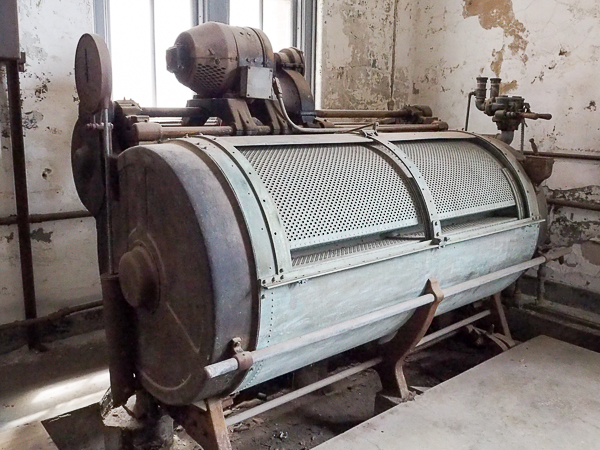
Our first stop was a critical piece of the facility: the laundry.
The importance of cleanliness in the treatment of disease was just gaining traction among conservative medical men (led by nurses) in the late 19th and early 20th centuries, but it was embraced at Ellis Island. From the way that wards were constructed and ventilated to the sterilization of tools, even mattresses, every precaution was taken against the spread of disease.
This is a washing machine.
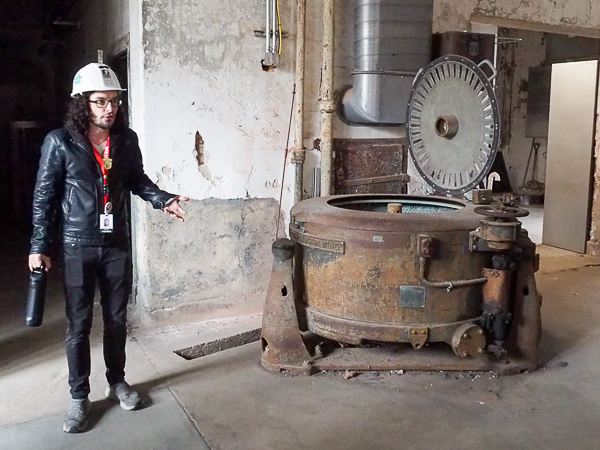
And this a spin-dryer.
Our guide was an enthusiastic presenter with many great stories and insights.
Treatment at the hospital was not free. Immigrants who could not pay were deported. If the families could not afford the cost of treatment, and many could not, immigrant aid societies might help. Another resource was the steamship company, which was responsible for insuring the health of their passengers and which had to return rejected immigrants to their place of origin if they could not be cured. They traveled first or second class, for free, so the company had an incentive to help them pass immigration.
Children under 14 who were deported could have a family member, often the mother or an older sibling, travel with them. Many had no home left in the old world.
It was truly an "Island of hope; island of tears."
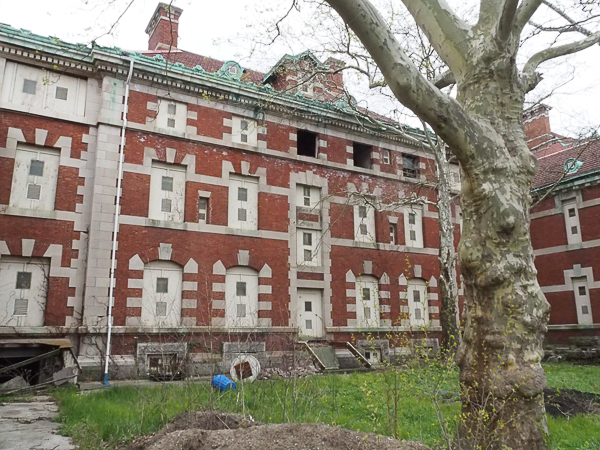
The general hospital, which directly faced the main facility on the other side, was where non-contagious cases such as pregnancies and injuries were sent.
The windows are now shielded with a preservation covering designed to protect the glass, and keep out intruders while allowing moisture to escape. Don't know what happened with those upper story windows.
This tour reminded us of our visit to Philadelphia's Eastern State Penitentiary in 2014.
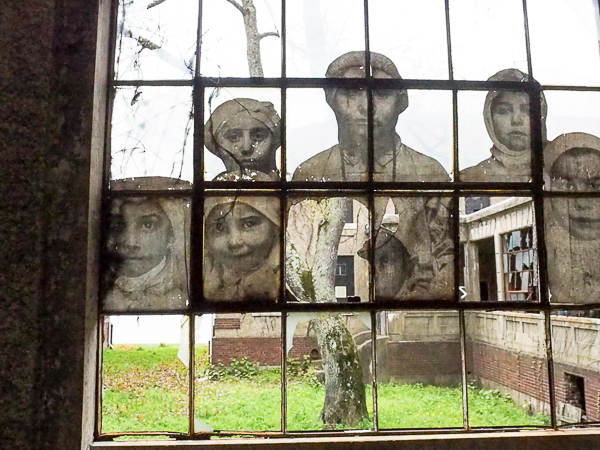
French street artist JR created a series of installations throughout the hospital. He used archival photographs to tell the emigrant story. The installation is intended to be temporary -- it will slowly decay over time like the buildings themselves. See JR's website for a complete set of the images. Also at the website is a short film with Robert de Niro -- the imagined story of an immigrant who didn't make it and who haunts the islands undetected.
This group of young girls were being treated for favus, a horrible, and highly contagious, fungal disease. If it could not be cured, it was grounds for deportation. At the time the hospital was active, the only successful treatment was pulling out the hair (by the roots, where the infection lurks!) and using caustic cleansing agents. In later years, it was treated with radiation, before the cumulative effects of radiation exposure were understood. The course of treatment was (and is) lengthy and painful. Imagine being a child, isolated from family, in a strange place where you don't speak the language, being subjected to frightening treatment.
These children all had bandaged heads to protect the scalp during the treatment cycle. When the children were cured they were released to their families.
The disease still exists and the fungus has become resistant to formerly effective medications.
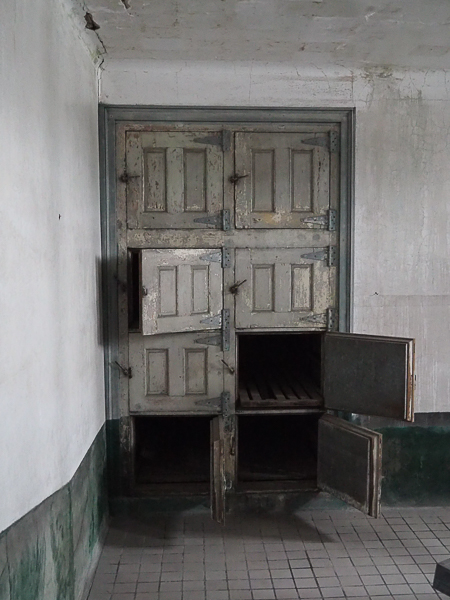
The hospital was a noted teaching hospital in its day. The number and rarity of conditions from all parts of the world, made it desirable for students who were unlikely to see them elsewhere in the US.
The morgue had space for eight cadavers that could be used for teaching. There was a refrigeration unit to keep them from premature decomposition.
I don't remember if the guide spoke about what kinds, if any, permissions were needed for the deceased to become subjects. Medical ethics were not robust in those days.
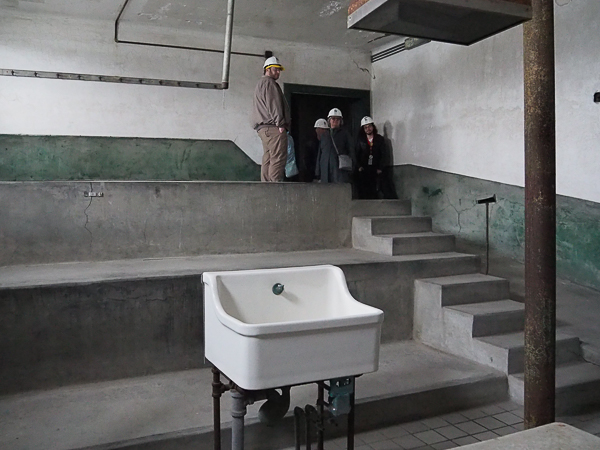
Students sat on the tiers during demonstrations and dissections.
A couple of the men in the group were electricians who were delighted by the vintage electrical motors, machines, and panels that we came across. There were constant comments of "Hey Jack, take a look at this!" "Wow, I've only seen pictures of things like that."
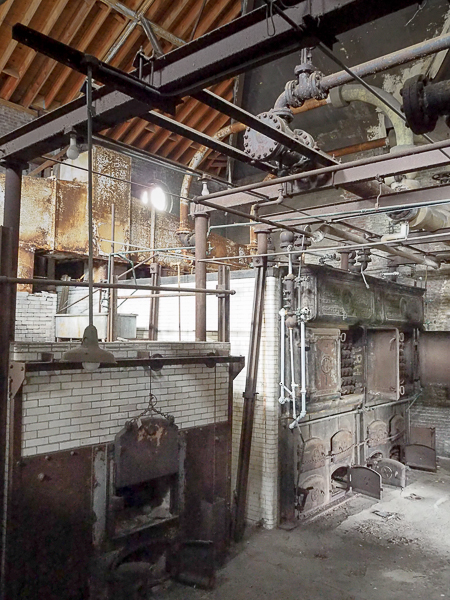
The boiler room was fantastic.
We were assured that no one was cremated there.
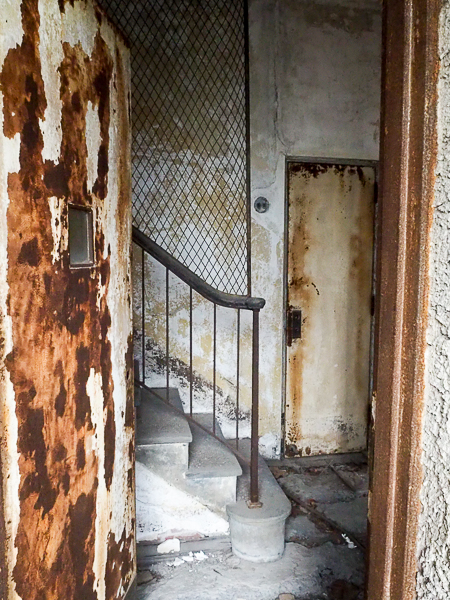
Many of the medical staff lived in the hospital -- usually on the upper floors.
We weren't allowed to go there.
The hospital was a major training ground for the Public Health Service.
Although many of the commissioners in charge of immigration were not in favor of accepting "too many" or "the wrong kind" of immigrants, the doctors and nurses in these hospitals were committed to delivering the best standard of care available at the time in a humane and caring way.
Even so, many immigrants, especially children, who couldn't speak the language and had never seen a doctor before were frightened and traumatized by being separated from their families for an unknown amount of time.
Many patients were shocked at the necessity for stripping for examinations and some had never seen bathtubs and weren't thrilled with the idea of bathing -- even less of being bathed.
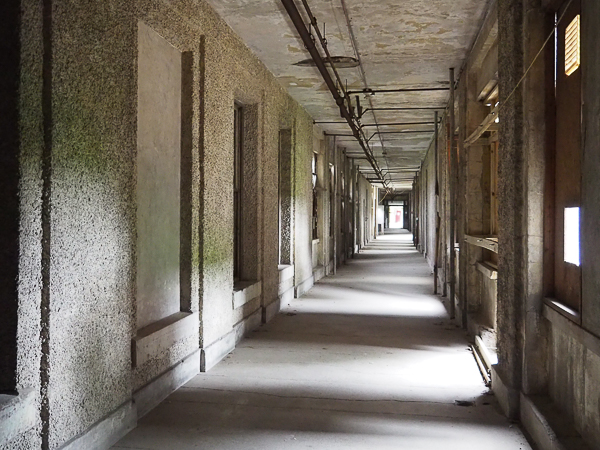
Florence Nightingale was one of the first who advocated for fresh air and sunshine as an adjunct treatment for disease so wards were well ventilated and airy. Transportation between wards or different areas of the hospital was originally done along open galleries. This was a problem in the colder months and after bitter complaint by both patients and staff, the galleries were enclosed, but still had large windows to admit light and air.
Tubercular patients in particular were required to spend a large part of each day in the fresh air and sunlight. I hope they were well-bundled in the wintertime. There was no cure for TB at the time, so I don't recall whether those diagnosed were inevitably deported or if some recovered enough to be admitted.
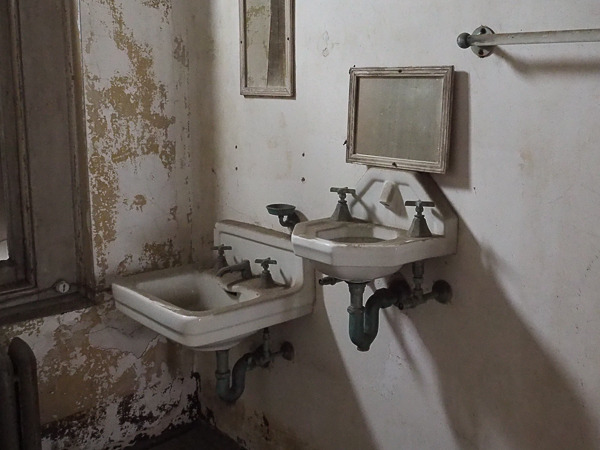
The wards were separated by disease, measles in one, favus in another, pneumonia in another, etc., to prevent cross-contamination.
The tuberculosis wards had a special kind of sink arrangement. The lower sink was used for handwashing and other types of hygiene.
The upper sink was used for spitting and coughing. That infectious material went through a separate plumbing system and was incinerated to prevent spreading disease.
Unfortunately the regular plumbing effluvia was discharged into the harbor without treatment. Ick.
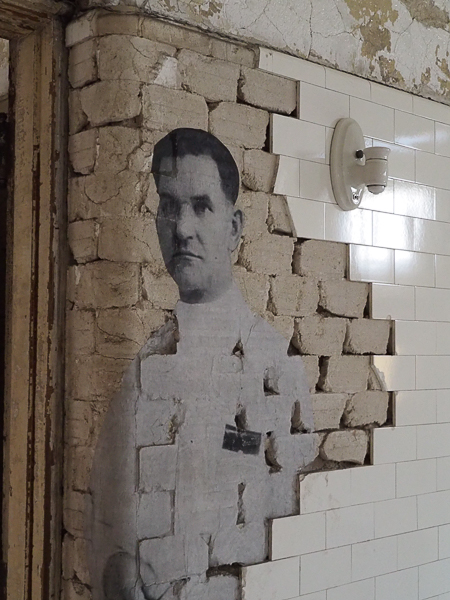
The surgical suites were state-of-the-art. All of the equipment and dressings were sterile, the doctors and nurses wore gloves and masks, and the operating rooms were lined with easy to sanitize tile.
This image is of Dr. Kimmel. The guide told us that he was noted for something, but I don't remember what and I have only been able to find out his name, not the what.
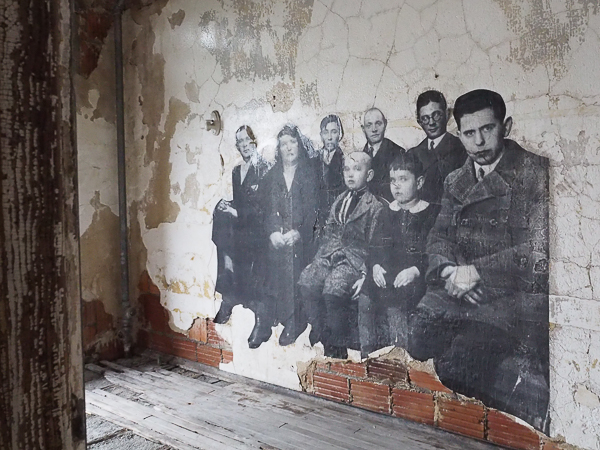
Although the treatment of physical illnesses was admirable, the diagnosis and treatment of mental conditions was less so. The men at the top were caught up in the pseudo-sciences of phrenology and eugenics. The immigration authorities were concerned about admitting those who were "feeble-minded" or morally inferior as determined by their looks, race, or origin. Southern Europeans, Africans, Slavs, and Jews were singled out for additional testing.
Although there were attempts to devise "intelligence tests" that would apply across language barriers and cultures, they didn't take into account the exhaustion and confusion brought on by the rigors of the long struggle to get this far. Some otherwise capable individuals were refused entry.
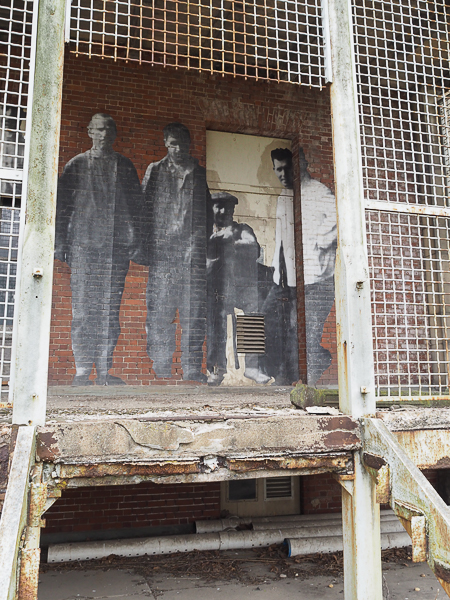
Mental illness was another barrier to admission. After an early suicide, a special unit of the hospital was set aside for those believed to be mentally ill to keep them safely confined until they could be deported.
The values of fresh air and sunlight were still offered, but in a confined space.
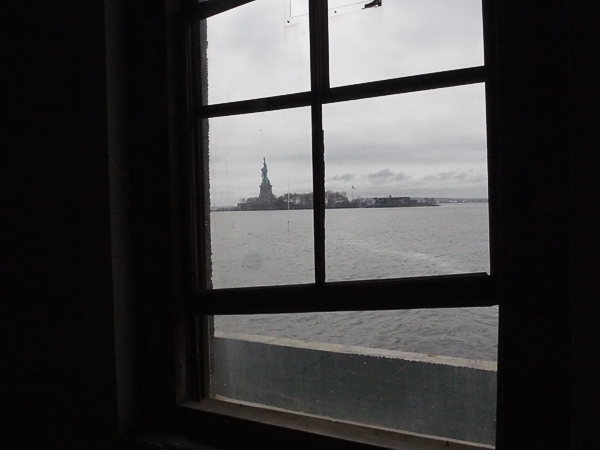
The Statue of Liberty as seen from one of the children's wards.
The guide told us that someone once made the comment that it was cruel to have this "so near yet so far away" view, but a one-time patient at the hospital demurred. It was wonderful to be cared for and also see Lady Liberty as an inspiration to get better.
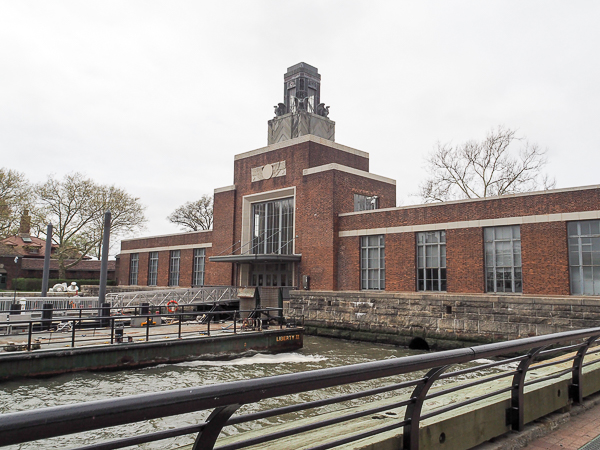
Those who were lucky enough to be cured left Ellis Island for a new life in America from this terminal. It must have been a day of great rejoicing to board the shuttle to Manhattan.
Their illnesses were cured, their babies were delivered (mothers and children received the best care available at the time), and no epidemic of infectious disease was started from anyone processed through Ellis Island.
The days or weeks of isolation from family and friends were over.
Click your "back" button to return to the previous page or click for our picture album.